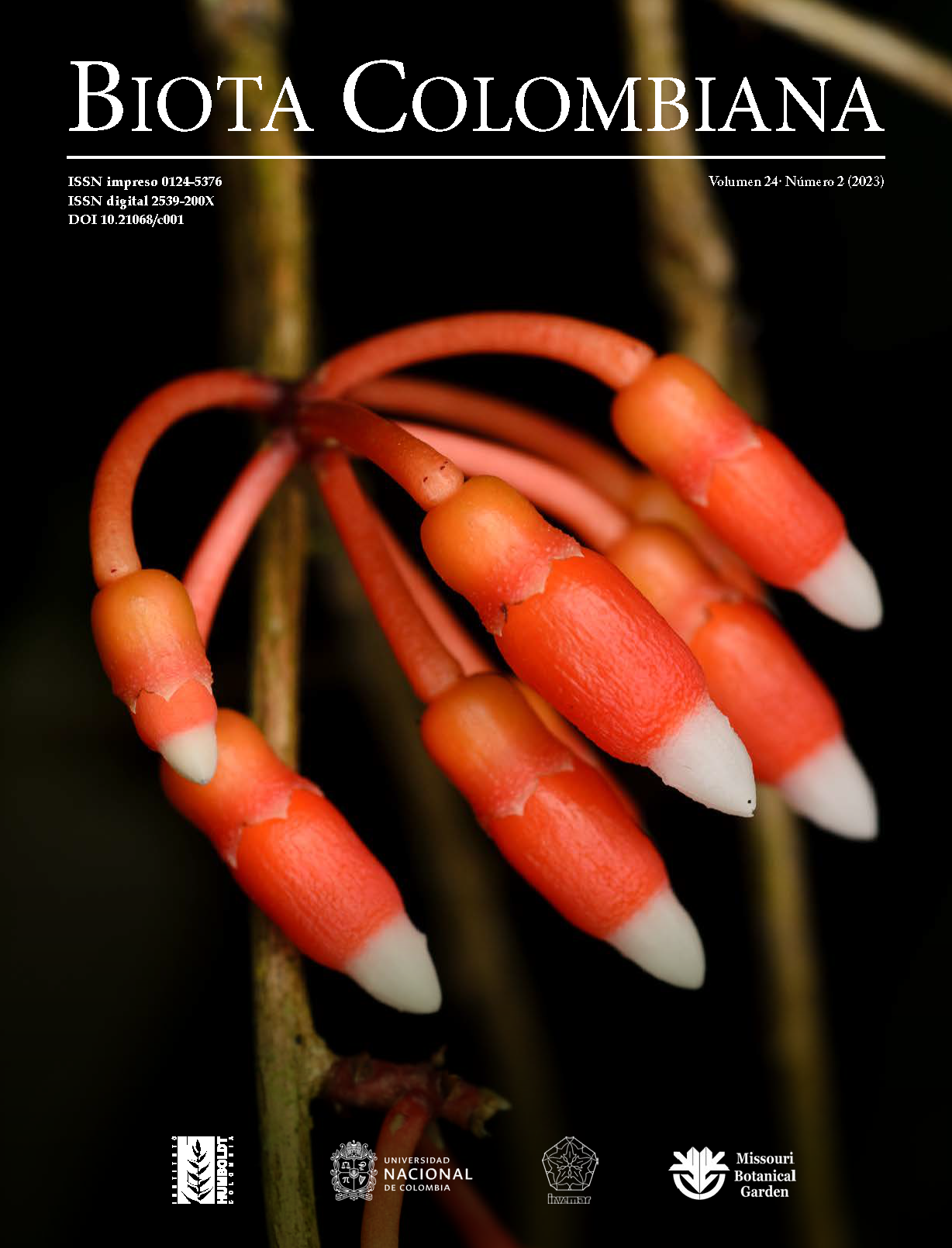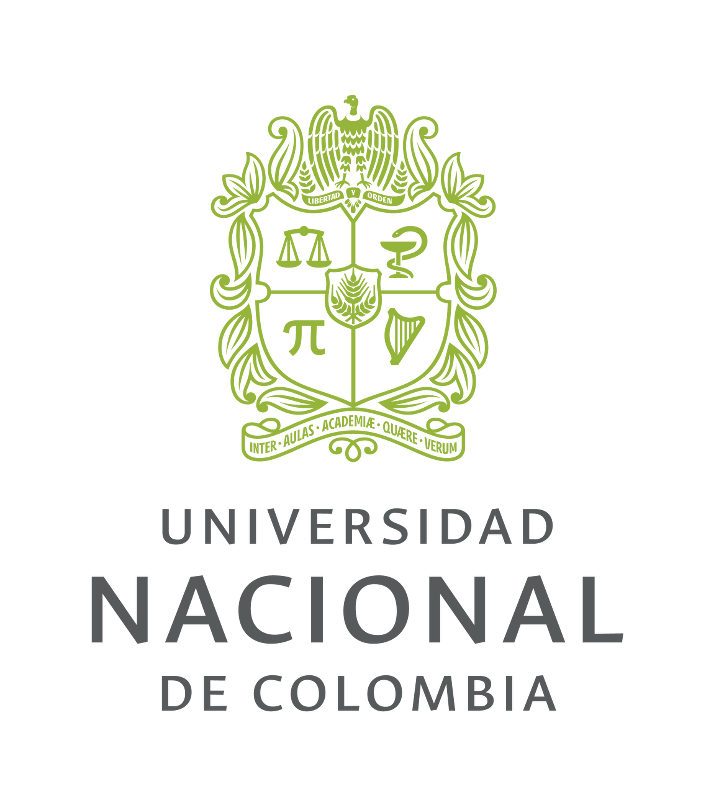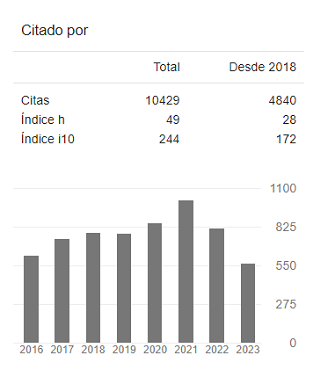Resumen (es):
En las comunidades coralinas, los peces herbívoros ocupan un papel principal en el mantenimiento y control de algas que son la base de la cadena trófica en los arrecifes coralinos. Entre los peces herbívoros de los arrecifes de coral, la familia Acanthuridae es de las más abundantes. Los efectos en los arrecifes de esta familia pueden variar en función de sus densidades, la estabilidad del ecosistema y sus interacciones, por lo que determinar el estado de sus poblaciones resulta de interés. En el archipiélago de San Andrés, Providencia y Santa Catalina (ASAP) falta información del estado actual de las abundancias y densidades de este grupo. Por lo tanto, mediante censos visuales de especies del género Acanthurus se estimaron los estados poblacionales en comunidades coralinas del ASAP y las diferencias poblacionales entre los sitios evaluados, lo cual evidenció un total de 6075 individuos, además de una relación positiva de abundancias en las islas de San Andrés y Providencia con respecto a las islas cayos Bolívar y Serrana. En cuanto a la preferencia de hábitat de juveniles se encontró una especialización y preferencia de hábitat de A. coeruleus por las zonas arrecifales, entretanto A. tractus mostró preferencia por los manglares.
Resumen (en):
In coral communities, herbivorous fish play a major role in maintaining and controlling algae, which are the base of the food chain in coral reefs. Among the herbivorous fish of coral reefs, the family Acanthuridae is one of the most abundant. Effects of this family on coral reefs can vary depending on their densities, ecosystem stability, and their interactions; therefore, determining the status of their populations is a concern. In the archipelago of San Andrés, Providencia, and Santa Catalina (ASAP) there is a lack of information on the status of the abundances and densities of this group. Through visual censuses of species of the genus Acanthurus, the population states in the ASAP coral communities and the population differences between the evaluated sites (San Andrés, isla cayo Bolívar, isla cayo Serrana and Providencia) were estimated. Showing an abundance of 6075 individuals, in addition to a positive relationship of abundances in the islands of San Andrés and Providencia with respect to the Bolívar and Serrana keys. Regarding the habitat preference of juveniles, a specialization and habitat preference of A. coeruleus was found for reef zones, while A. tractus showed a preference for mangroves.
Palabras clave:
Acanthurus, abundance, Archipielago of San Andres, herbivorous, reef (en)
Referencias
Adam, T. C., Schmitt, R. J., Holbrook, S. J., Brooks, A. J., Edmunds, P. J., Carpenter, R. C., y Bernardi, G. (2011). Herbivory, Connectivity, and Ecosystem Resilience: Response of a Coral Reef to a Large-Scale Perturbation. Plos One, 6(8), e23717. https://doi.org/10.1371/journal.pone.0023717
Almany, G. R. (2004). Differential effects of habitat complexity, predators and competitors on abundance of juvenile and adult coral reef fishes. Oecologia, 141(1), 105-113. https://doi.org/10.1007/s00442-004-1617-0
Barriga-Bonilla, E. (1969). La isla de San Andrés: contribuciones al conocimiento de su ecología, flora, fauna y pesca. Universidad Nacional de Colombia.
Bellwood, D. R. (2003). Origins and escalation of herbivory in fishes: a functional perspective. Paleobiology, 29(1), 71-83. http://dx.doi.org/10.1666/0094-8373(2003)029<0071:OAEOHI>2.0.CO;2
Bellwood, D. R., Hughes, T. P., Folke, C., y Nyström, M. (2004). Confronting the coral reef crisis. Nature, 429(6994), 827-833. https://doi.org/10.1038/nature02691
Bouchon‐Navaro, Y., Bouchon, C., Kopp, D., y Louis, M. (2006). Weight–length relationships for 50 fish species collected in seagrass beds of the Lesser Antilles. Journal of Applied Ichthyology, 22(4), 322-324. https://doi.org/10.1111/j.1439-0426.2006.00715.x
Burkepile, D. E., y Hay, M. E. (2008). Herbivore species richness and feeding complementarity affect community structure and function on a coral reef. Proceedings of the National Academy of Sciences, 105(42), 16201-16206. https://doi.org/10.1073/pnas.0801946105
Díaz-Pulido, G. (1997). Informe nacional sobre el estado de la biodiversidad en Colombia: ecosistemas marinos y costeros. Invemar.
Díaz-Pulido, G., Sánchez, J. A., Zea, S., Díaz, J. M., y Garzón-Ferreira, J. (2012). Esquemas de distribución espacial en la comunidad bentónica de arrecifes coralinos continentales y oceánicos del Caribe colombiano. Revista Academia Colombiana de Ciencias, 28(108), 337-347.
Done, T. T., Ogden, J. J., Wiebe, W., y Rosen, B. (1996). Biodiversity and ecosystem function of coral reefs. En H. A. Mooney, J. H. Cushman, E. Medina, O. E. Sala, y E. D. Schulze (Eds.), Functional Roles of Biodiversity: A Global Perspective. Wiley.
Dorenbosch, M., Verberk, W. C. E. P., Nagelkerken, I., y Van der Velde, G. (2007). Influence of habitat configuration on connectivity between fish assemblages of Caribbean seagrass beds, mangroves and coral reefs. Marine Ecology Progress Series, 334, 103-116. https://doi.org/ 10.3354/meps334103
Dromard, C. R., Bouchon-Navaro, Y., Harmelin-Vivien, M., y Bouchon, C. (2015). Diversity of trophic niches among herbivorous fishes on a Caribbean reef (Guadeloupe, Lesser Antilles), evidenced by stable isotope and gut content analyses. Journal of Sea Research, 95, 124-131. https://doi.org/10.1016/j.seares.2014.07.014
Duarte, S. A., y Acero P., A. (1988). Hábitos alimentarios de los peces del género Acanthurus (Perciformes: Acanthuridae) en la región de Santa Marta (Caribe colombiano). Revista de Biología Tropical, 36(2B), 399-405.
Duran, A., Adam, T. C., Palma, L., Moreno, S., Collado‐Vides, L., y Burkepile, D. E. (2019). Feeding behavior in Caribbean surgeonfishes varies across fish size, algal abundance, and habitat characteristics. Marine Ecology, 40(4), e12561. https://doi.org/10.1111/maec.12561
Ferreira, C. E. L., Floeter, S. R., Gasparini, J. L., Ferreira, B. P., y Joyeux, J. C. (2004). Trophic structure patterns of Brazilian reef fishes: a latitudinal comparison. Journal of Biogeography, 31(7), 1093-1106. https://doi.org/10.1111/j.1365-2699.2004.01044.x
Froese, R., y Pauly, D. (Eds.). (2019). FishBase. World Wide Web electronic publication. http://www.fishbase.org
Geister, J. (1973). Los arrecifes de la isla de San Andrés (mar Caribe, Colombia). Mitteilungen aus dem Instituto Colombo-Alemán de Investigaciones Científicas, 7, 211-228. http://boletin.invemar.org.co/ojs/index.php/boletin/article/view/553/543
Gobernación del Archipiélago de San Andrés, Providencia y Santa Catalina. (2019). Geografía del Archpielago. https://www.sanandres.gov.co/index.php?option=com_content&view=article&id=116
Gómez, D. I., Segura, C., Sierra, P. C., y Garay, J. (Eds.). (2012). Atlas de la Reserva de Biósfera Seaflower. Archipiélago de San Andrés, Providencia y Santa Catalina. Coralina-Invemar.
Hawkins, J. P., y Roberts, C. M. (2004). Effects of artisanal fishing on Caribbean coral reefs. Conservation Biology, 18(1), 215-226. https://doi.org/10.1111/j.1523-1739.2004.00328.x
Heenan, A., y Williams, I. D. (2013). Monitoring herbivorous fishes as indicators of coral reef resilience in American Samoa. PloS One, 8(11). https://doi.org/10.1371/journal.pone.0079604
Hernández-Landa, R. C., y Aguilar-Perera, A. (2019). Structure and composition of surgeonfish (Acanthuridae) and parrotfish (Labridae: Scarinae) assemblages in the south of the Parque Nacional Arrecife Alacranes, southern Gulf of Mexico. Marine Biodiversity, 49(2), 647-662. https://doi.org/10.1007/s12526-017-0841-x
Hernández‐Landa, R. C., Acosta‐González, G., Núñez‐Lara, E., y Arias‐González, J. E. (2015). Spatial distribution of surgeonfish and parrotfish in the north sector of the Mesoamerican Barrier Reef System. Marine Ecology, 36(3), 432-446. https://doi.org/10.1111/maec.12152
Holbrook, S. J., Schmitt, R. J., Adam, T. C., y Brooks, A. J. (2016). Coral reef resilience, tipping points and the strength of herbivory. Scientific Reports, 6(1), 35817. https://doi.org/10.1038/srep35817
Kopp, D., Bouchon-Navaro, Y., Louis, M., Legendre, P., y Bouchon, C. (2012). Spatial and temporal variation in a Caribbean herbivorous fish assemblage. Journal of Coastal Research, 28(1A), 63-72. https://doi.org/10.2112/JCOASTRES-D-09-00165.1
Lewis, S. M. (1985). Herbivory on coral reefs: algal susceptibility to herbivorous fishes. Oecologia, 65(3), 370-375.
Marshell, A., y Mumby, P. J. (2015). The role of surgeonfish (Acanthuridae) in maintaining algal turf biomass on coral reefs. Journal of Experimental Marine Biology and Ecology, 473, 152-160. https://doi.org/10.1016/j.jembe.2015.09.002
Mejía, L. S., y Garzón-Ferreira, J. (2000). Estructura de comunidades de peces arrecifales en cuatro atolones del archipiélago de San Andrés y Providencia (Caribe sur occidental). Revista de Biología Tropical, 48(4), 883-896.
Morgan, I. E., y Kramer, D. L. (2005). Determinants of social organization in a coral reef fish, the blue tang, Acanthurus coeruleus. Environmental Biology of Fishes, 72(4). https://doi.org/10.1007/s10641-004-2861-1
Mow, J. M., Aguilera, A., Tabet, S. (2003). Archipiélago de San Andrés, Providencia y Santa Catalina: una Reserva de la Biosfera en el Caribe colombiano. Coralina.
Nagelkerken, I. (2009). Evaluation of nursery function of mangroves and seagrass beds for tropical decapods and reef fishes: Patterns and underlying mechanisms. En Ecological Connectivity Among Tropical Coastal Ecosystems (pp. 357-399). Springer.
Nagelkerken, I., Van der Velde, G., Gorissen, M. W., Meijer, G. J., Van’t Hof, T., y Den Hartog, C. (2000). Importance of mangroves, seagrass beds and the shallow coral reef as a nursery for important coral reef fishes, using a visual census technique. Estuarine, Coastal and Shelf Science, 51(1), 31-44. https://doi.org/10.1006/ecss.2000.0617
Nagelkerken, I., Roberts, C. V., Van Der Velde, G., Dorenbosch, M., Van Riel, M. C., De La Moriniere, E. C., y Nienhuis, P. H. (2002). How important are mangroves and seagrass beds for coral-reef fish? The nursery hypothesis tested on an island scale. Marine Ecology Progress Series, 244, 299-305. https://doi.org/10.3354/meps244299
Oksanen, J., Blanchet, F., Kindt, R., et al. (2016). Vegan: Community Ecology Package. R Package Version 2.3-4. http://CRAN.R-project.org/package=vegan
R Core Team (2021). R: A Language and Environment for Statistical Computing. R Foundation for Statistical Computing, Vienna, Austria. https://www.R-project.org/
Rincón-Díaz, M. N., Sierra-Rozo, O., y Santos-Martínez, A. (2012). Patrones ontogénicos y estacionales de peces cirujano (Acanthuridae) según el uso de hábitat en un paisaje insular: Reserva de Biosfera Seaflower, Caribe colombiano. Proceedings of the 65th Gulf and Caribbean Fisheries Institute, 365-369.
Robertson, D. R. (1991). Increases in surgeonfish populations after mass mortality of the sea urchin Diadema antillarum in Panama indicate food limitation. Marine Biology, 111(3), 437-444.
Robertson, D. R., Ackerman, J. L., Choat, J. H., Posada, J. M., y Pitt, J. (2005). Ocean surgeonfish Acanthurus bahianus. I. The geography of demography. Marine Ecology Progress Series, 295, 229-244. https://doi.org/10.3354/meps295229
Rocha, L. A., Bass, A. L., Robertson, D. R., y Bowen, B. W. (2002). Adult habitat preferences, larval dispersal, and the comparative phylogeography of three Atlantic surgeonfishes (Teleostei: Acanthuridae). Molecular Ecology, 11(2), 243-251. https://doi.org/10.1046/j.0962-1083.2001.01431.x
Russ, G. (1984a). Distribution and abundance of herbivorous grazing fishes in the central Great Barrier Reef. I. Levels of variability across the entire continental shelf. Marine Ecology Progress Series, 20(1), 23-34.
Russ, G. (1984b). Distribution and abundance of herbivorous grazing fishes in the central Great Barrier Reef. II. Patterns of zonation of mid-shelf and outer shelf reefs. Marine Ecology Progress Series, 20(1), 35-44.
Samoilys, M. A., y Carlos, G. (2000). Determining methods of underwater visual census for estimating the abundance of coral reef fishes. Environmental Biology of Fishes, 57(3), 289-304. https://doi.org/10.1023/A:1007679109359
Sánchez, J. A., Gómez-Corrales, M., Gutiérrez-Cala, L., Vergara, D. C., Roa, P., González-Zapata, F. L., y Sarmiento, A. (2019). Steady decline of corals and other benthic organisms in the SeaFlower Biosphere Reserve (Southwestern Caribbean). Frontiers in Marine Science, 6, 73. https://doi.org/10.3389/fmars.2019.00073
Santos Martínez, A. S., Hinojosa, S., y Sierra Rozo, O. (2009). Proceso y avance hacia la sostenibilidad ambiental: la reserva de biosfera Seaflower, en el Caribe colombiano. Cuadernos del Caribe, 7(13), 7-23.
Shantz, A. A., Ladd, M. C., y Burkepile, D. E. (2020). Overfishing and the ecological impacts of extirpating large parrotfish from Caribbean coral reefs. Ecological Monographs, 90(2), e01403. https://doi.org/10.1002/ecm.1403
Trip, E. L., Choat, J. H., Wilson, D. T., y Robertson, D. R. (2008). Inter-oceanic analysis of demographic variation in a widely distributed Indo-Pacific coral reef fish. Marine Ecology Progress Series, 373, 97-109. https://doi.org/10.3354/meps07755
Wilkinson, C. (2002). Status of coral reefs of the world: 2002. Australian Institute of Marine Science.
WWF. (2006). Mejores prácticas de pesca en arrecifes coralinos. Guía para la colecta de información que apoye el Manejo de Pesquerías Basado en Ecosistemas. WWF México/Centroamérica.
Cómo citar

Esta obra está bajo una licencia internacional Creative Commons Atribución-NoComercial-SinDerivadas 4.0.
Derechos de autor 2023 Instituto de Investigación de Recursos Biológicos Alexander Von Humboldt


















